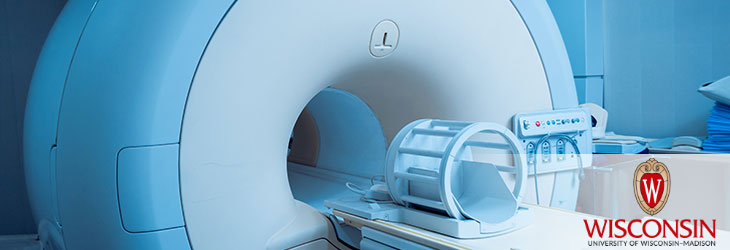Radiation Therapy

Rapid Three-Dimensional Elasticity Imaging
WARF: P130117US01
Inventors: Tomy Varghese, Atul Ingle
The Wisconsin Alumni Research Foundation (WARF) is seeking commercial partners interested in developing a high-speed system for acquiring three-dimensional tissue elasticity reconstructions useful during ablation therapy.
Overview
Elastography is a type of imaging technique that reveals the stiffness of tissues. It commonly is used to detect tumors and other abnormalities that cause changes in local tissue stiffness. Measurements can be output as values or displayed as an image.
Generally, stiffness is gauged by how tissue yields under some force or pressure. In ‘dynamic’ elastography, a low-frequency vibration is applied and the resulting compression/shear waves are detected using ultrasound. In ‘quasi-static’ elastography, two images of the tissue obtained at different states of compression are compared to assess stiffness.
The stiffness values or maps produced by elastography can be utilized to monitor radiofrequency (RF) or microwave ablation used to treat tumors. During ablation—when an electrode is inserted into tissue to kill tumor cells—ultrasound data acquired sequentially can be used to produce three-dimensional elasticity images of the hardened lesion. However, this can be time-consuming, especially when multiple images must be obtained at each location. A sleeker imaging technique needs to support real-time processes like ablation.
Generally, stiffness is gauged by how tissue yields under some force or pressure. In ‘dynamic’ elastography, a low-frequency vibration is applied and the resulting compression/shear waves are detected using ultrasound. In ‘quasi-static’ elastography, two images of the tissue obtained at different states of compression are compared to assess stiffness.
The stiffness values or maps produced by elastography can be utilized to monitor radiofrequency (RF) or microwave ablation used to treat tumors. During ablation—when an electrode is inserted into tissue to kill tumor cells—ultrasound data acquired sequentially can be used to produce three-dimensional elasticity images of the hardened lesion. However, this can be time-consuming, especially when multiple images must be obtained at each location. A sleeker imaging technique needs to support real-time processes like ablation.
The Invention
UW–Madison researchers have developed an ultrasonic probe assembly and a reconstruction technique for rapid three-dimensional elasticity imaging using limited data.
The probe sends an ultrasonic beam of energy into tissue and receives echoes from the displaced material generally along an axis. Ultrasound data is acquired over a set of planes (between four and six in number) angularly spaced and sharing a common axis. A computer receives the ultrasound data and determines elasticity of the material at multiple points within each plane. A three-dimensional reconstruction then is generated. This reconstruction is faster than the traditional sequential data acquisition for three-dimensional visualization.
The probe sends an ultrasonic beam of energy into tissue and receives echoes from the displaced material generally along an axis. Ultrasound data is acquired over a set of planes (between four and six in number) angularly spaced and sharing a common axis. A computer receives the ultrasound data and determines elasticity of the material at multiple points within each plane. A three-dimensional reconstruction then is generated. This reconstruction is faster than the traditional sequential data acquisition for three-dimensional visualization.
Applications
- Real-time monitoring of operations such as liver ablation
- Three-dimensional elastography and blood flow reconstruction
- Other quantitative ultrasound imaging
Key Benefits
- Requires less data
- Good resolution
- Simple method for generating elasticity data
- Data well suited for radial acquisition and circumferential smoothness
Additional Information
For More Information About the Inventors
Related Technologies
For current licensing status, please contact Jeanine Burmania at [javascript protected email address] or 608-960-9846